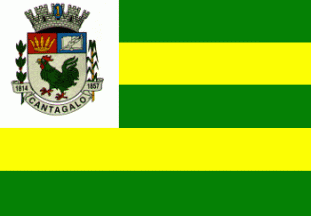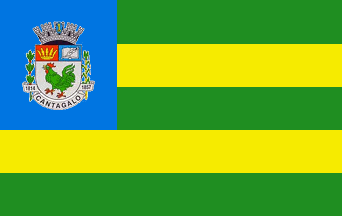 image by André Pires Godinho, 20
August 2005
image by André Pires Godinho, 20
August 2005
Last modified: 2012-04-07 by ian macdonald
Keywords: rio de janeiro | cantagalo | stripes: horizontal (5 | green | yellow) | rooster |
Links: FOTW homepage |
search |
disclaimer and copyright |
write us |
mirrors
 image by André Pires Godinho, 20
August 2005
image by André Pires Godinho, 20
August 2005
The flag is divided in five stripes in the Brazilian national colors (green and
yellow). The coat of arms shows a rooster--the name of the city meaning something
like "sing, rooster" in English.
Area 717.5 Sq. Km.
Population 19,809
Source: Municipal government
André Pires Godinho, 2 April 2003
The municipality of Cantagalo (19,826 inhabitants in 2010; 749 sq. km) is located in north central Rio de Janeiro State, on the border with Minas Gerais, 200 km of Rio de Janeiro. Cantagalo was originally the den of a gold smuggler named Manoel Henriques who settled around 1780 in the "forbidden zone" located close to the gold-producing areas of Minas Gerais. The local tradition says that Henriques, nicknamed Mão de Luva ("Hand in the Glove") was indeed the Duke of Santo Tirso, expelled from Portugal by the Marquis of Pombal after a romance with Infante Mary I. When she visited him in jail secretly, she kept her glove when he kissed her hand for the last time. There is no historical evidence that this unfortunate duke ever existed. Mão de Luva's band extracted so much gold without paying tax that a first expedition was sent against them in 1784, commanded by Sergeant Pedro Afonso Galvão de São Martinho. A second expedition organized in 1786 allowed the capture of the smugglers and the suppression of their camp. Pedro Afonso Galvão de São Martinho coined for the first time the name of the place, as the hamlet of "Canta Gallo do descoberto do Macacu", without explaining its origin. When visiting the region in 1809, the English mineralogist John Mawe was told that the name, lit. "The Rooster's Crow", was coined after a rooster crowing on a stockade had eventually allowed the expedition to localize the smugglers' den. Vice-Roy Luiz de Vasconcellos e Souza commissioned the Gold General Superintendent of the Rio de Janeiro Captaincy, Manoel Pinto da Cunha e Souza, to resettle the place and to establish an official gold- mining camp, which was done on 2 June 1787. The first settlement was set up on the very same site as the suppressed, illegal camp. The first colonists, coming mostly from Minas Gerais, the Azores and Santo Antonio de Sá, cleared the woods to set up crops. Within 20 years, big estates cultivating coffee and sugar cane were established, while the gold fever got extinct in 1814.
The "vila" of São Pedro de Cantagalo was established in 9 March 1814, succeeding the hamlet and district of Novas Minas de Cantagallo and seceding from Santo Antonio de Sá. For a while the main coffee producer in the Rio de Janeiro Province, Cantagalo was made a "cidade" on 2 October 1857. The local aristocracy included some of the most fluent people in Brazil, the first of them being Antônio Clemente Pinto, subsequently made the 1st Baron of Nova Friburgo; the Baron owned some 20 estates and palaces in Cantagalo and Rio de Janeiro. Another 18 inhabitants of Cantagalo were ennobled until the proclamation of the Republic. The Baron's son, Bernardo Clemente Pinto Sobrinho, founded the building of the railway, whose station was inaugurated in Cantagalo 1876 and which remained for years in the hands of the family. The coffee crisis caused the decline of the municipality, which lost a significant part of it territory through the emancipation of districts. Coffee was succeeded by cattle-breeding, and, most important, by limestone extraction, which caused the second boom of Cantagalo. The town is today the 3rd producer of cement in Brazil.
The full-sized and table flags shown on the photo of the Mayor
definitively prove that the flag with the blue canton is *the*
municipal flag and not a "variant"; it should be shown on top of the
page on the FOTW website.
http://www.cantagalo.rj.gov.br/web/index.php/o-prefeito
The flag of Cantagalo uses green and yellow as the national colors. The five stripes represent the five districts of Cantagalo (seat of the municipality), Santa Rita da Floresta, Euclidelândia, São Sebastião do Paraíba and Boa Sorte.
The coat of arms of Cantagalo is prescribed by Municipal Law No. 2 of
20 June 1964, as follows:
"Portuguese shield. Argent an heraldic rooster vert (green)
represented with open beak and the right leg raised, crested and armed
(nails, feet and spurs) gules (red), the chief per pale, 1. Gules a
feather coronet or, 2. Azure (blue) an open book argent and a
classical quill of the same. Below the shield a scroll argent
inscribed '1814 - CANTAGALO - 1857'. The shield supported dexter by a
branch of coffee and sinister by a sugar cane. The shield surmounted
with a five-towered argent mural crown, representing a "cidade",
charged with an oval azure (blue) charged with a key or."
The Portuguese shield recalls the Lusitanian origin of the country.
The rooster ("galo") represents the name of the municipality, making
the arms canting; its posture represents force and courage. The
feather coronet represents the Coroados and Goytacazes tribes, which
once ruled the region. The book and quill, standings for 'Os Sertões',
Euclides da Cunha*'s masterpiece, considered as the Brazilian
Lusiads**', are a tribute to the municipality's most famous child.
Coffee and cane are the crops that once allowed to growth and increase
of the municipality.
The key represents the former patron saint of the municipality, St.
Peter of Cantagalo***. The years stand for the emancipation of the
"vila" of Cantagalo from Santo Antônio de Sá ("1814") and for the
establishment of the "cidade" ("1857").
Or represents force, argent represents candor, gules represents
intrepidness, blue represents serenity and green represents abundance.
http://www.cantagalo.rj.gov.br/web/index.php/simbolos-municipais
*The writer, sociologist, journalist, historian and engineer Euclides
da Cunha (1866-1909) is the most famous child of Cantagalo. Expelled
from the Military College in 1888 for his support to the Republicans,
he defended the Republic in the newspaper "O Estado de São Paulo" and
was reincorporated into the army after the proclamation of the
Republic. When the Canudos uprising broke out in 1897 in the northeast
of Bahia, da Cunha first disapproved the uprising, calling it "Our
Vendée", as a reference to the monarchist uprising during the French
Revolution. Five years later, he published the book "Os Sertões", in
which he completely changed his mind, analyzing in depth the causes
and outcome of the uprising. In 1905, da Cunha led the Brazilian-
Peruvian commission appointed to delimit the border in Amazonia; his
posthumous book "À Margem da História" describes the destruction of
the primary forest to grow rubber tree. Da Cunha was killed in Rio de
Janeiro in a duel or an ambush by Dilermando de Assis, the young
lieutenant who was his wife's lover - and married her after the
writer's death. After years of research and struggle, the descendants
of Euclides da Cunha obtained in 1983 the repatriation of his brain
from the Quinta da Boa Vista National Museum to the Euclides da Cunha
Culture Hall, established in Cantagalo on 3 October 1965.
http://www.cantagalo.rj.gov.br/web/index.php/filhos-ilustres/139-euclides-da-cunha
**The Lusiads ("Os Lusíadas"), published in 1572 by Luís Vaz de Camões (c. 1524-1580) are the Portuguese national epic, focused on the Portuguese voyages of discovery during the 15th-16th centuries.
***The rooster is a traditional attribute of St. Peter, particularly appropriate given the name of the town. In the gospels, during the Last Supper, Jesus foretold that Peter would deny him three times before the following cockcrow.
Ivan Sache, March 2012
 image located by Dirk Schönberger,
12 October 2011
image located by Dirk Schönberger,
12 October 2011
Source:
http://www.cantagalo.rj.gov.br/web/index.php/simbolos-municipais
Similar to the flag above, but with a blue canton instead of white.
Official website at
http://www.cantagalo.rj.gov.br
Dirk Schönberger, 12
October 2011